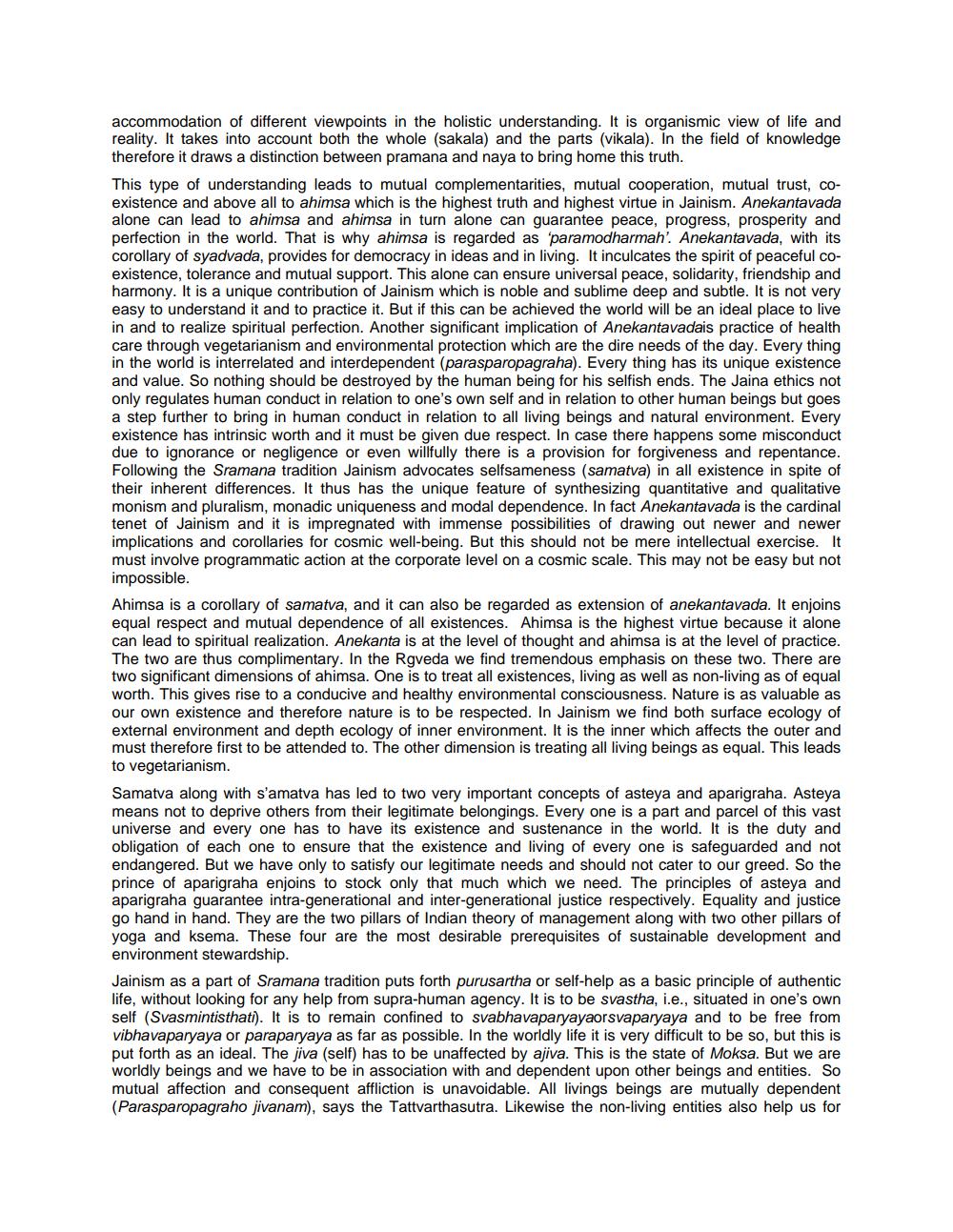Book Title: Jaina View Towards Philosophical Inquiry and Harmonious Ways of Living Author(s): S R Bhatt Publisher: ZZZ Unknown View full book textPage 8
________________ accommodation of different viewpoints in the holistic understanding. It is organismic view of life and reality. It takes into account both the whole (sakala) and the parts (vikala). In the field of knowledge therefore it draws a distinction between pramana and naya to bring home this truth. This type of understanding leads to mutual complementarities, mutual cooperation, mutual trust, coexistence and above all to ahimsa which is the highest truth and highest virtue in Jainism. Anekantavada alone can lead to ahimsa and ahimsa in turn alone can guarantee peace, progress, prosperity and perfection in the world. That is why ahimsa is regarded as 'paramodharmah! Anekantavada, with its corollary of syadvada, provides for democracy in ideas and in living. It inculcates the spirit of peaceful coexistence, tolerance and mutual support. This alone can ensure universal peace, solidarity, friendship and harmony. It is a unique contribution of Jainism which is noble and sublime deep and subtle. It is not very easy to understand it and to practice it. But if this can be achieved the world will be an ideal place to live in and to realize spiritual perfection. Another significant implication of Anekantavadais practice of health care through vegetarianism and environmental protection which are the dire needs of the day. Every thing in the world is interrelated and interdependent (parasparopagraha). Every thing has its unique existence and value. So nothing should be destroyed by the human being for his selfish ends. The Jaina ethics not only regulates human conduct in relation to one's own self and in relation to other human beings but goes a step further to bring in human conduct in relation to all living beings and natural environment. Every existence has intrinsic worth and it must be given due respect. In case there happens some misconduct due to ignorance or negligence or even willfully there is a provision for forgiveness and repentance. Following the Sramana tradition Jainism advocates selfsameness (samatva) in all existence in spite of their inherent differences. It thus has the unique feature of synthesizing quantitative and qualitative monism and pluralism, monadic uniqueness and modal dependence. In fact Anekantavada is the cardinal tenet of Jainism and it is impregnated with immense possibilities of drawing out newer and newer implications and corollaries for cosmic well-being. But this should not be mere intellectual exercise. It must involve programmatic action at the corporate level on a cosmic scale. This may not be easy but not impossible. Ahimsa is a corollary of samatva, and it can also be regarded as extension of anekantavada. It enjoins equal respect and mutual dependence of all existences. Ahimsa is the highest virtue because it alone can lead to spiritual realization. Anekanta is at the level of thought and ahimsa is at the level of practice. The two are thus complimentary. In the Rgveda we find tremendous emphasis on these two. There are two significant dimensions of ahimsa. One is to treat all existences, living as well as non-living as of equal worth. This gives rise to a conducive and healthy environmental consciousness. Nature is as valuable as our own existence and therefore nature is to be respected. In Jainism we find both surface ecology of external environment and depth ecology of inner environment. It is the inner which affects the outer and must therefore first to be attended to. The other dimension is treating all living beings as equal. This leads to vegetarianism. Samatva along with s'amatva has led to two very important concepts of asteya and aparigraha. Asteya means not to deprive others from their legitimate belongings. Every one is a part and parcel of this vast universe and every one has to have its existence and sustenance in the world. It is the duty and obligation of each one to ensure that the existence and living of every one is safeguarded and not endangered. But we have only to satisfy our legitimate needs and should not cater to our greed. So the prince of aparigraha enjoins to stock only that much which we need. The principles of asteya and aparigraha guarantee intra-generational and inter-generational justice respectively. Equality and justice go hand in hand. They are the two pillars of Indian theory of management along with two other pillars of yoga and ksema. These four are the most desirable prerequisites of sustainable development and environment stewardship. Jainism as a part of Sramana tradition puts forth purusartha or self-help as a basic principle of authentic life, without looking for any help from supra-human agency. It is to be svastha, i.e., situated in one's own self (Svasmintisthati). It is to remain confined to svabhavaparyayaorsvaparyaya and to be free from vibhavaparyaya or paraparyaya as far as possible. In the worldly life it is very difficult to be so, but this is put forth as an ideal. The jiva (self) has to be unaffected by ajiva. This is the state of Moksa. But we are worldly beings and we have to be in association with and dependent upon other beings and entities. So mutual affection and consequent affliction is unavoidable. All livings beings are mutually dependent (Parasparopagraho jivanam), says the Tattvarthasutra. Likewise the non-living entities also help us forPage Navigation
1 ... 6 7 8 9 10 11
